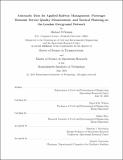| dc.contributor.advisor | Nigel H.M. Wilson and Jinhua Zhao. | en_US |
| dc.contributor.author | Frumin, Michael S | en_US |
| dc.contributor.other | Massachusetts Institute of Technology. Operations Research Center. | en_US |
| dc.coverage.spatial | e-uk-en | en_US |
| dc.date.accessioned | 2011-03-07T14:37:43Z | |
| dc.date.available | 2011-03-07T14:37:43Z | |
| dc.date.copyright | 2010 | en_US |
| dc.date.issued | 2010 | en_US |
| dc.identifier.uri | http://hdl.handle.net/1721.1/61512 | |
| dc.description | Thesis (S.M. in Transportation)--Massachusetts Institute of Technology, Dept. of Civil and Environmental Engineering; and, (S.M.)--Massachusetts Institute of Technology, Sloan School of Management, Operations Research Center, 2010. | en_US |
| dc.description | This electronic version was submitted by the student author. The certified thesis is available in the Institute Archives and Special Collections. | en_US |
| dc.description | Cataloged from student-submitted PDF version of thesis. | en_US |
| dc.description | Includes bibliographical references (p. 201-209). | en_US |
| dc.description.abstract | The broad goal of this thesis is to demonstrate the potential positive impacts of applying automatic data to the management and tactical planning of a modern urban railway. Tactical planning is taken here to mean the set of transport-specific analysis and decisions required to manage and improve a railway with time horizons measured in weeks, months, or up to a year and little or no capital investment requirements. This thesis develops and tests methods to (i) estimate on-train loads from automatic measurements of train payload weight, (ii) estimate origin-destination matrices by combining multiple types of automatic data, (iii) study passenger incidence (station arrival) behavior relative to the published timetable, (iv) characterize service quality in terms of the difference between automatically measured passenger journey times and journey times implied by the published timetable. It does so using (i) disaggregate journey records from an entry- and exit-controlled automatic fare collection system, (ii) payload weight measurements from "loadweigh" sensors in train suspension systems, and (iii) aggregate passenger volumes from electronic station gatelines. The methods developed to analyze passenger incidence behavior and service quality using these data sources include new methodologies that facilitate such analysis under a wide variety of service conditions and passenger behaviors. The above methods and data are used to characterize passenger demand and service quality on the rapidly growing, largely circumferential London Overground network in London, England. A case study documents how a tactical planning intervention on the Overground network was influenced by the application of these methods, and evaluates the outcomes of this intervention. The proposed analytical methods are judged to be successful in that they estimate the desired quantities with sufficient accuracy and are found to make a positive contribution to the Overground's tactical planning process. It is concluded that relative measures of service quality such as the one developed here can be used in cross-sectional analysis to inform tactical planning activity. However, such measures are of less utility for longitudinal evaluation of tactical planning interventions when the basis against which service quality is judged (in this case the timetable) is changed. Under such circumstances, absolute measures, such as total observed passenger journey times, should be used as well. | en_US |
| dc.description.statementofresponsibility | by Michael S. Frumin. | en_US |
| dc.format.extent | 209 p. | en_US |
| dc.language.iso | eng | en_US |
| dc.publisher | Massachusetts Institute of Technology | en_US |
| dc.rights | M.I.T. theses are protected by
copyright. They may be viewed from this source for any purpose, but
reproduction or distribution in any format is prohibited without written
permission. See provided URL for inquiries about permission. | en_US |
| dc.rights.uri | http://dspace.mit.edu/handle/1721.1/7582 | en_US |
| dc.subject | Civil and Environmental Engineering. | en_US |
| dc.subject | Operations Research Center. | en_US |
| dc.title | Automatic data for applied railway management : passenger demand, service quality measurement, and tactical planning on the London Overground Network | en_US |
| dc.type | Thesis | en_US |
| dc.description.degree | S.M. | en_US |
| dc.description.degree | S.M.in Transportation | en_US |
| dc.contributor.department | Massachusetts Institute of Technology. Department of Civil and Environmental Engineering | |
| dc.contributor.department | Massachusetts Institute of Technology. Operations Research Center | |
| dc.contributor.department | Sloan School of Management | |
| dc.identifier.oclc | 703227527 | en_US |

